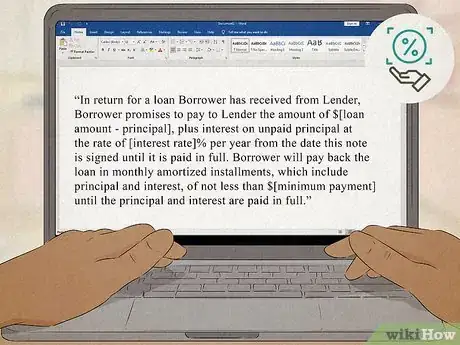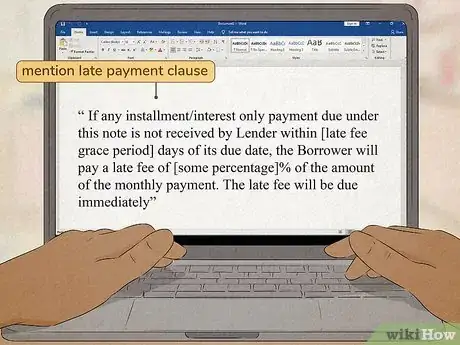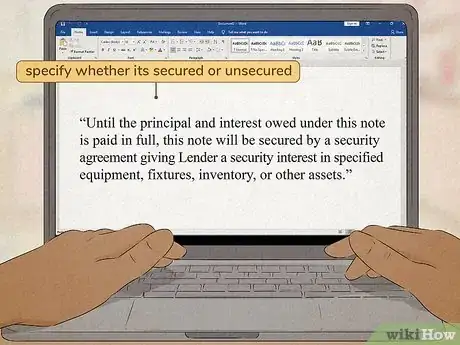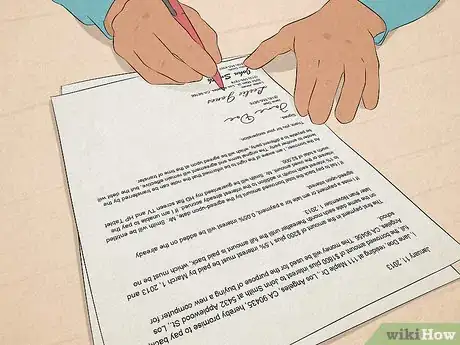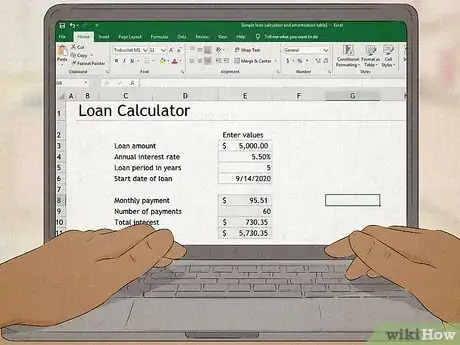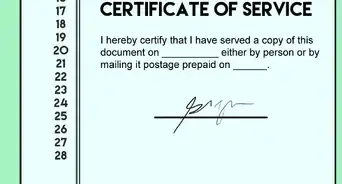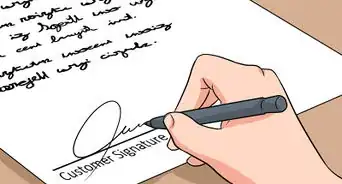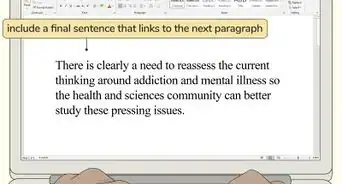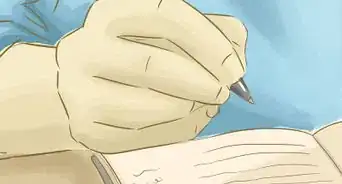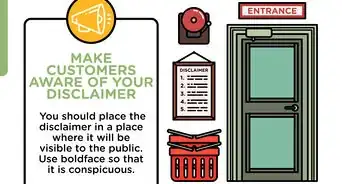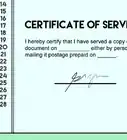This article was co-authored by Clinton M. Sandvick, JD, PhD. Clinton M. Sandvick worked as a civil litigator in California for over 7 years. He received his JD from the University of Wisconsin-Madison in 1998 and his PhD in American History from the University of Oregon in 2013.
There are 9 references cited in this article, which can be found at the bottom of the page.
This article has been viewed 670,879 times.
When you loan money to someone, it is important to create a legal document that lays out how the loaned money will be repaid. This is the case even if you are loaning money to a friend, colleague, or relative. This legal document, called a promissory note, is a written instrument that contains a promise by one party to pay another party a definite sum of money either on demand or at a specified future date.[1] Your promissory note should contain various important provisions including the amount due, the interest rate, and the maturity date.[2] Follow the steps in this article to create a clear, concise, and legally enforceable promissory note.
Steps
Sample Promissory Note
Understanding Promissory Notes
-
1Think of a promissory note as a negotiable instrument. A negotiable instrument is a special writing that can be transferred from one person to another and exchanged for money.[3] If you want to make a promissory note non-negotiable, meaning the note will not be able to be transferred from one person to another, you must simply write "non-negotiable" somewhere on the promissory note.[4]
- For example, assume you loan money to a friend and execute a promissory note. The promissory note requires your friend to repay the amount loaned, plus interest, on a certain date. At this point, you are considered the "holder" of the promissory note, because you have possession of the note and can ask your friend, "the borrower," for the amount of money owed on the date agreed upon. However, because a promissory note is usually negotiable, you may transfer your right to collect to your brother. If you do this, your brother will become the holder of the note and will be able to ask your friend for the money owed when it becomes due. However, let's now assume the promissory note was made non-negotiable. If this is the case, you will not be able to transfer your rights as the holder to another person (i.e., your brother), and only you will be able to collect from the borrower (i.e., your friend).
- Understanding the idea of a negotiable instrument will help you in creating a promissory note that achieves your desired intentions (i.e., whether you want the note to be negotiable or non-negotiable).
-
2Know the difference between a note and a draft. A note is a promise to pay money while a draft is an order to pay money.[5] Before you create a promissory note, you should try and understand these subtle differences. When you create your promissory note, be sure you word the note in such a way as to make it a promise and not a demand.Advertisement
-
3Meet the requirements of a legally acceptable promissory note. In order to create a legally enforceable promissory note, the law generally requires that certain criteria be fulfilled. Most states follow the Uniform Commercial Code ("UCC"), which requires that:
- The note be in writing, be signed, and promises the payment of money;
- The promise must be unconditional;
- The amount of money must be a fixed amount (with or without interest);
- The instrument must be payable to holder;
- The promise must be payable at a definite time; and
- The promise must not include any other act in addition to the payment of money.[9]
Choosing The Type of Payment Plan You Will Offer
-
1Contemplate an installment loan without interest. If you choose to offer this type of loan, the borrower will pay off the loan in equal payments over a specified period of time.[10]
- With this type of loan, you will include a payment provision in your promissory note that looks like this: "In return for a loan Borrower has received from Lender, Borrower promises to pay to Lender the amount of $[total loan amount - principal]. Borrower will make equal installments of $[monthly payment amount] per month until the principal is paid in full. Payments will be due on the [date of monthly payments] day of each month, beginning on [date first monthly payment due]."[11]
- This type of payment plan is good for loaning small amounts of money to people you are close with. If you are making a loan of more than $10,000 with no interest, the Internal Revenue Service (IRS) may require you to pay taxes in an amount that reflects interest, even if you received none.[12]
-
2Think about an installment loan with interest. With this type of loan, the borrower pays off the loan in equal payments over a specified period of time, with part of the payment going towards interest and part of the payment going towards principal.[13]
- If you choose this type of loan, consider a payment provision that looks like this: "In return for a loan Borrower has received from Lender, Borrower promises to pay to Lender the amount of $[loan amount - principal], plus interest on unpaid principal at the rate of [interest rate]% per year from the date this note is signed until it is paid in full. Borrower will pay back the loan in monthly amortized installments, which include principal and interest, of not less than $[minimum payment] until the principal and interest are paid in full."[14]
- This type of payment option is great for loaning larger sums of money. If you are loaning more than $10,000 to someone, include interest so you avoid the potential adverse tax consequences that may otherwise arise.[15]
-
3Consider a lump-sum payment. Here, the borrower will pay you the money borrowed, plus interest, in one single payment.[16]
- If you are creating a lump-sum payment provision with interest, use this language: "In return for a loan Borrower has received from Lender, Borrower promises to pay to Lender the amount of $[loan amount - principal], plus interest on unpaid principal at the rate of [interest rate]% per year from the date this note is signed until it is paid in full. Borrower will repay the entire amount owed by [due date]."[17]
- If you are creating a lump-sum payment provision without interest, use this language: "In return for a loan Borrower has received from Lender, Borrower promises to pay to Lender the amount of $[loan amount] by [date payment is due]."[18]
- A lump sum payment provision can be used when you want to reduce the potential interest charges incurred by the other party. This is the case because, with a lump sum payment, the party paying back your loan can pay off the loan quicker, therefore avoiding interest payments over an extended period of time.
-
4Think about interest only payments. With interest only payments, the borrower will make payments of interest only, and will then pay off the principal in one lump sum.[19]
- If you use this type of loan, use the following provision: "In return for a loan Borrower has received from Lender, Borrower promises to pay to Lender the amount of $[loan amount - principal], plus interest on unpaid principal at the rate of [interest rate]% per year from the date this note is signed until it is paid in full. Borrower will pay interest of $[amount of interest] on the [date of payments], beginning [date first payment due]. Borrower will pay the principal in full on or before [date by which loan must be repaid], together with any accrued interest."[20]
- Interest only loan payments are great for those that want low payments during the early life of the loan.[21] This is the case because when you are only making interest payments, they will be lower than a payment that included both interest and principal. However, you may not want to use this type of payment plan if the other party is concerned about the large principal payment that will be due later in the life of the loan.
Drafting Your Promissory Note
-
1
-
2Provide a statement of negotiability. Towards the beginning of your promissory note, you may want to include a statement clarifying whether the instrument is going to be negotiable or not.
- If you want to make your promissory note negotiable, all you need to say is, "This note is negotiable."
- If you want to make your promissory note non-negotiable, simply state, "This note is non-negotiable."
-
3Include your payment provision. After your statement of negotiability, insert the payment provision you wrote based on the type of loan you are providing the borrower. Look at the section about choosing the type of loan you will provide for various acceptable provisions.
-
4Lay out a late payment clause. Depending on what type of loan you will be offering, you may want to include a late payment clause. A late payment clause will ensure you are compensated in case the borrower does not make their payment on time.
- If you are offering an installment or interest only payment option, consider the following late payment provision: "If any installment/interest only payment due under this note is not received by Lender within [late fee grace period] days of its due date, the Borrower will pay a late fee of [some percentage]% of the amount of the monthly payment. The late fee will be due immediately.[24] If you want to include an acceleration clause, which will allow you to demand payment in full immediately upon the borrower's late payment, you can use this provision: "If any installment/interest only payment is not received by Lender within [acceleration grace period] days of its due date, Lender may demand, in writing, that Borrower repay the entire amount of unpaid principal immediately. After receiving Lender's demand, Borrower will immediately pay the entire unpaid principal."[25]
- If you are offering a lump sum payment option, use this provision: "If payment due under this note is not received by Lender within [late fee grace period] days of its due date, the Borrower will pay a late fee of [some percentage]% of the amount of the payment. The late fee will be due immediately.[26]
-
5Give payment and notice addresses. Next you will want to include an address where the borrower should send payments, as well as an address where you, the lender, can send any notices.[27]
-
6Choose whether the loan will be secured or unsecured. Towards the end of your promissory note, you need to specify whether the loan you are offering will be secured or unsecured. An unsecured loan is a loan supported only by the borrower's creditworthiness, and not by any collateral.[28] On the other hand, a secured loan is a loan that has collateral attached to it.[29] With a secured loan, if the borrower defaults the lender can collect the collateral as a form of repayment.
- If you are choosing to make the loan unsecured, simply state that the note is unsecured.[30]
- On the other hand, if you are planning to make your note secured, you will need to include a provision such as this: "Until the principal and interest owed under this note is paid in full, this note will be secured by a security agreement giving Lender a security interest in specified equipment, fixtures, inventory, or other assets."[31] You will then have to describe the property, in detail, that you are securing as collateral.
Executing Your Promissory Note
-
1Give the promissory note to the borrower. Once you have decided what type of loan you will offer the borrower and you have drafted the promissory note, you will give the note to the borrower. At this point, the borrower should read over the terms and understand them.
-
2Sign the note provide the loan. The borrower will need to sign and date the promissory note once they have read it over. While it is not imperative that you, the lender, sign the promissory note, you can if you wish to. Once the promissory note is signed, you should provide the loan money to the borrower.
-
3Fill out a repayment schedule as you go. If you have provided a loan that will be paid back over time, you should consider filling out a repayment schedule as you go. This repayment schedule will help you keep track of payments as they come in, as well as how much is left to be paid back. Generally, a repayment schedule will have the date of the payment, the total amount of the payment, and how much of that payment went to both principal and interest.
Requesting Repayment
-
1Know when it is time to confront the other party. Sometimes, when you make a loan to another party, that party does not pay it back as promised. In this type of situation, it is best to follow the language of your contract. However, at some point, you will need to confront the other party and discuss ways you can get your money back.
- For example, if your contract has a late payment clause, follow that clause and charge the other party a late fee. However, if, after a couple of months of not receiving any payment (including no late fee payments), you should consider confronting the other party and requesting repayment.
-
2Clarify that you indeed offered a loan. A lot of borrowers claim the loan they took was actually a gift.[32] If you find yourself in this situation, reiterate to the other party that it was indeed a loan and that you expect to be paid back.[33] Bring a copy of your promissory note to emphasize this fact.
-
3Create a post-loan commitment.[34] Even if you already have a promissory note in place, consider writing up a new contract that compliments the original. In this contract, create a large section on repayment and the expectations you have.
-
4
-
5Have a credit card machine. One excuse people often have is that they cannot make the payments because all they have is a credit card. As a solution, consider purchasing a credit card machine so you can accept their form of payment.[37] There are a number of ways to receive a credit card reader that can easily be installed on your smart phone or tablet. For example, Square offers a free credit card reader so long as you use their payment services.[38]
-
6
-
7
-
8Send a demand letter.[45] If all else fails, send a legal demand letter and threaten a lawsuit.[46] The promissory note is a legal contract and if it is not fulfilled, the courts will help you recoup damages. To write a demand letter, address the original terms of your agreement, request repayment, and state what you will do if you do not get paid back (i.e., file a lawsuit).[47]
References
- ↑ http://www.investopedia.com/terms/p/promissorynote.asp
- ↑ http://www.investopedia.com/terms/p/promissorynote.asp
- ↑ http://www.nolo.com/legal-encyclopedia/the-ucc-negotiable-instruments-part-1-2.html
- ↑ http://www.nolo.com/legal-encyclopedia/the-ucc-negotiable-instruments-part-1-2.html
- ↑ https://www.law.cornell.edu/ucc/3/3-104
- ↑ http://www.nolo.com/legal-encyclopedia/the-ucc-negotiable-instruments-part-1-2.html
- ↑ http://www.nolo.com/legal-encyclopedia/the-ucc-negotiable-instruments-part-1-2.html
- ↑ http://www.nolo.com/legal-encyclopedia/the-ucc-negotiable-instruments-part-1-2.html
- ↑ http://www.nolo.com/legal-encyclopedia/the-ucc-negotiable-instruments-part-1-2.html
- ↑ https://www.nolo.com/products/promissory-note-pr401.html
- ↑ https://www.nolo.com/products/promissory-note-pr401.html
- ↑ http://denhalaw.com/low-to-no-interest-rate-loans-to-family-be-careful/
- ↑ https://www.nolo.com/products/promissory-note-pr401.html
- ↑ https://www.nolo.com/products/promissory-note-pr401.html
- ↑ http://denhalaw.com/low-to-no-interest-rate-loans-to-family-be-careful/
- ↑ https://www.nolo.com/products/promissory-note-pr401.html
- ↑ https://www.nolo.com/products/promissory-note-pr401.html
- ↑ https://www.nolo.com/products/promissory-note-pr401.html
- ↑ https://www.nolo.com/products/promissory-note-pr401.html
- ↑ https://www.nolo.com/products/promissory-note-pr401.html
- ↑ http://www.mortgagecalculator.org/helpful-advice/interest-only-mortgages.php
- ↑ https://www.nolo.com/products/promissory-note-pr401.html
- ↑ https://www.nolo.com/products/promissory-note-pr401.html
- ↑ https://www.nolo.com/products/promissory-note-pr401.html
- ↑ https://www.nolo.com/products/promissory-note-pr401.html
- ↑ https://www.nolo.com/products/promissory-note-pr401.html
- ↑ https://www.nolo.com/products/promissory-note-pr401.html
- ↑ http://www.investopedia.com/terms/u/unsecuredloan.asp
- ↑ http://moneyfor20s.about.com/od/shoppingforloans/g/secured_loan.htm
- ↑ https://www.nolo.com/products/promissory-note-pr401.html
- ↑ https://www.nolo.com/products/promissory-note-pr401.html
- ↑ http://www.creditcards.com/credit-card-news/8-ways-get-friends-repay-personal-loan-1265.php
- ↑ http://www.creditcards.com/credit-card-news/8-ways-get-friends-repay-personal-loan-1265.php
- ↑ http://www.creditcards.com/credit-card-news/8-ways-get-friends-repay-personal-loan-1265.php
- ↑ http://www.creditcards.com/credit-card-news/8-ways-get-friends-repay-personal-loan-1265.php
- ↑ http://www.creditcards.com/credit-card-news/8-ways-get-friends-repay-personal-loan-1265.php
- ↑ http://www.creditcards.com/credit-card-news/8-ways-get-friends-repay-personal-loan-1265.php
- ↑ http://www.creditcards.com/credit-card-news/8-ways-get-friends-repay-personal-loan-1265.php
- ↑ http://www.creditcards.com/credit-card-news/8-ways-get-friends-repay-personal-loan-1265.php
- ↑ http://www.creditcards.com/credit-card-news/8-ways-get-friends-repay-personal-loan-1265.php
- ↑ http://www.creditcards.com/credit-card-news/8-ways-get-friends-repay-personal-loan-1265.php
- ↑ http://www.creditcards.com/credit-card-news/8-ways-get-friends-repay-personal-loan-1265.php
- ↑ http://www.creditcards.com/credit-card-news/8-ways-get-friends-repay-personal-loan-1265.php
- ↑ http://www.creditcards.com/credit-card-news/8-ways-get-friends-repay-personal-loan-1265.php
- ↑ http://www.creditcards.com/credit-card-news/8-ways-get-friends-repay-personal-loan-1265.php
- ↑ http://www.creditcards.com/credit-card-news/8-ways-get-friends-repay-personal-loan-1265.php
- ↑ http://www.creditcards.com/credit-card-news/8-ways-get-friends-repay-personal-loan-1265.php
About This Article
To write a legal document for money owed, start by listing your name and address, along with the same information for the borrower. Next, include the payment provisions based on the type of loan you’re providing. For example, if you choose an installment loan with interest, state that the borrower will make x payments over a period of time, with part of the payment going towards the interest. Then, specify whether the loan will be unsecured, or secured with collateral. Finally, have the borrower sign and date the promissory note. To learn more, including how to deal with late or missed payments, read on.





